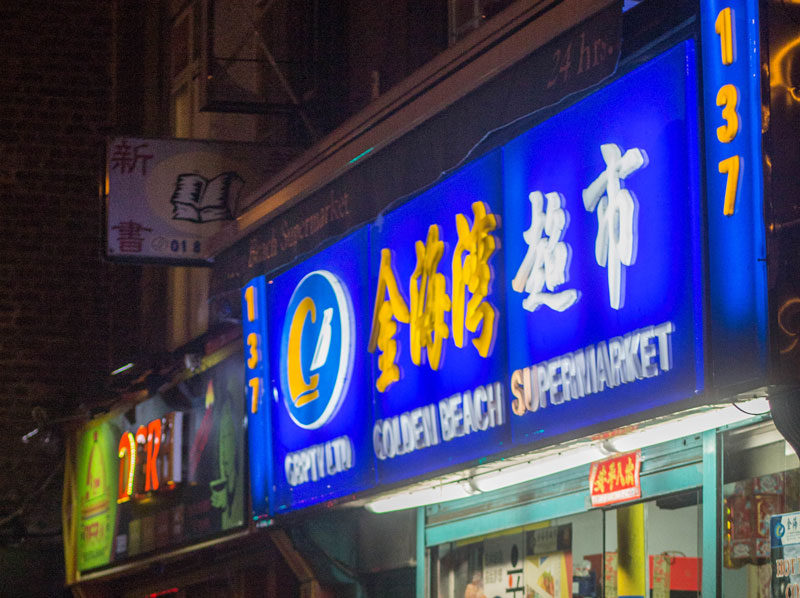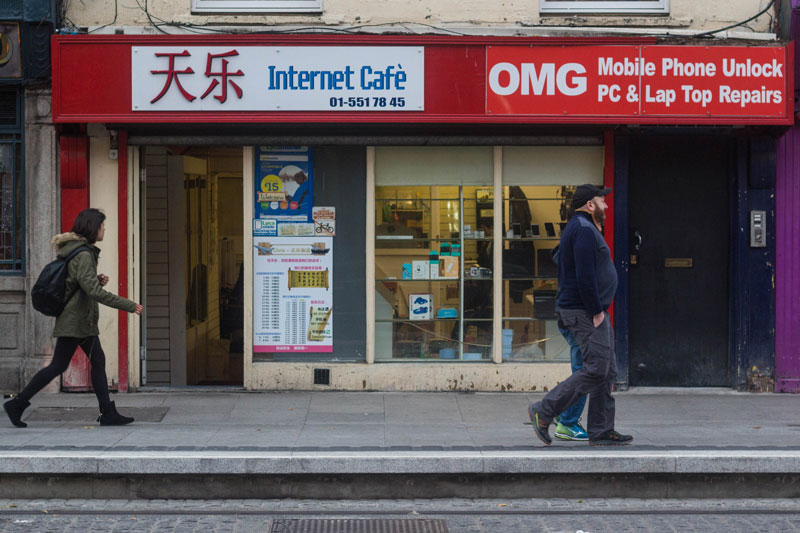
Where is Dublin’s Chinatown? Does Dublin even have one? This question has been hotly debated for several years now and remains unresolved. According to Google Maps, the exact location of Dublin’s Chinatown is the stretch of road between O’Connell St and Gardiner St, otherwise classified as Parnell St East. Is this burgeoning Asian quarter comparable to that of other western capitals such as New York, London or Melbourne? Perhaps not. That being said, in general, there is a definite surge towards the regeneration of O’Connell St. With these new proposals, such as the repaving of the sidewalk and the cross-city Luas plans, should there be an effort made to make Dublin’s unofficial Chinatown official?
Dublin’s Chinese population originally settled in the South Great George’s St area during the 1980s and 1990s. We can still see the remnants of this with the number of Asian restaurants in this area and the well-known Asian supermarket on Drury St. From then until now, the Chinese populace trickled across the Liffey and into the Northside. Nowadays, the areas with the densest Asian population are Capel St and, even more so, Parnell St East. In the Asian supermarket on Parnell St, one can find all the essentials: bags of jasmine, basmati or black rice, preserved duck eggs, squid and fish sauce, aloe vera drinks or even the ever-popular mochi and egg rolls. If this list does not whet the appetite, one could always buy some MSG to make even the most questionable piece of meat taste delicious.
For many, this area is an important hotpot of culture and community. Recently, a website has been set up by a few of the restaurateurs along Parnell St called China Town Dublin. Its description tells the reader that if they are looking for an “authentic ambiance with the finest eastern ingredients then you are going to love China Town Dublin. A selection of modern restaurants, take aways and even an Asian supermarket all within walking distance of one and other”. Disappointingly, the email address proved unresponsive despite the invitation to readers to “contact us should you wish to book or if you have any questions you feel we can help with”.
Parnell St East is lined with Chinese, Korean, Vietnamese and Japanese outlets offering all kinds of exotic dishes. A few highlights can be found in the restaurants offering Korean barbeque, sushi rolls and the Xiang or Szechuan cuisines. One can find particularly delightful dumplings in Jindal Chinese Korean restaurant, while Lee Kee restaurant is famed for its soups, hot and spicy squid and the fact that it is continuously running out of razor clams. The place to go for a hearty hotpot is eponymous Lao Hot Pot, which boasts an extensive hotpot menu, consisting of a choice of raw ingredients, which are cooked on a hot plate right before your eyes. The choice is endless and the dishes range from the more banal satay skewers to marinated duck tongues, dried jellyfish and griddled frogs legs.
Would the businesses benefit from officially designating this area as Chinatown? Many owners of the establishments along Parnell St East seem to think so. There are regular tour buses of Chinese people who come to dine in the district, hunting for authentic Asian food during their stay. They know about the area only through the Chinese community residing here in Dublin. Perhaps if the area was officially named Dublin’s Chinatown, more international tourists would be drawn towards the area. Not only would this attract tourists from different backgrounds, locals would also benefit from investment in the area, celebrating a culture and strengthening the community there. It could be modelled on the likes of London’s Chinatown, which provides Asian residents with that little bit of extra comfort and makes those that live there feel a little bit closer to home.
Speaking to The University Times, Lou Ri Kan from Lee Kee Dublin says that he thinks it is an issue for everyone to strive towards improving: “Fixing just one or two [problems] can’t improve the customer [base], we can do many things”. He says that “the Chinatown in Dublin is very [much] smaller and the government does not make sure that this is Chinatown, just as the people call it as Chinatown. It’s not like in England”. However, he believes that this can be remedied: “if we want to improve the business, it can’t be done with one problem or two problems, everyone should help” – and this includes the Irish government. Yuan Beaun from Lao Chinese and Korean BBQ agrees. She says: “If the government would encourage [investment] in Chinatown, towards Chinese-style buildings and things, it would improve the look of the street.” She thinks that by officially recognising Chinatown, it will help to cement the Chinese culture here and thus allow for it to flourish.

For the past 20 years, the idea of marking out a Chinese or Asian quarter has been pondered over by Dublin’s developers.
This line of thinking is not new or cutting edge. For the past 20 years, the idea of marking out a Chinese or Asian quarter has been pondered over by Dublin’s developers. A petition was initiated over a year ago, calling for a friendship arch to be erected on the corner of O’Connell St, which would distinguish the beginning of the unofficial Chinatown.
The petition that began in January of last year detailed that “Parnell Street is where the greatest concentration of the Chinese community in Dublin lives and works”, and continued by stating: “The street offers so much, there are Asian shops, restaurants, cultural centres, businesses and communities. Despite all of this we haven’t made the most of it, it is time to fully recognise our Chinatown and give it the boost it needs.”
But with the petition came controversy, and it was debated whether or not marking the block as “Chinatown” would undermine the other ethnicities that share this area. Is it really necessary to build up a dedicated area for solely one ethnic group? Developers are very conscious of avoiding making a ghetto of Dublin. Some argue that a concentration of cultures allows them to flourish while adding a distinctive flavour to the city, others disagree and think that the concept of a Chinatown in a city is obsolete and that integration should be encouraged instead. Thus, perhaps a rewording is in order – instead of branding Parnell St East as Chinatown, it would be more appropriate to mark it as a multicultural quarter.
Taking all concerns into consideration, the tagging of Dublin’s unofficial Chinatown as an official one may not be as straightforward as it seems. In a debate as part of the Chinese New Year celebrations earlier this year, Lorcan O’Connor, the Director of Carrolls Irish Gifts chain, spoke about the issue, stating: “We have looked at calling it the Oriental Restaurant Quarter, because Chinatown seems a bit narrow. Yet most people accept [that] there are other ethnic groups in there too.”
There are so many different ethnic groups in Dublin today. And Parnell St is not only home to the Asian contingent of the city. Before the Asian population crossed the river and moved their businesses to Parnell St, it was predominantly the African area of Dublin. Now, only a few hairdressers and one or two shops remain. Some African-Irish traders think that by officially signposting the area as Chinatown, their business will be hindered. It is feared that this could homogenise and brand the customers that visit the area, as they will be there for Asian food, products and culture and there for these alone. This is a risk that one has to consider before championing the funding of a friendship arch or encouraging the authentication of Dublin’s Chinatown.
Opposition also arises from those who object on historical grounds, for the street’s associations with national hero Charles Stewart Parnell. Regardless of your stance on the matter, one thing is certain: the area is in need of greater investment. For many years, this area of Dublin has been slowly decaying and even now it feels very run down. The central zone could be positively revitalised if it was turned into an oriental or multicultural quarter, showcasing the diverse types of culture and food on offer in modern Dublin. The new cross-city Luas will pass through Parnell St East, inevitably increasing the number of people who frequent this block.
The fact of the matter remains, whether it is official or not, Dublin’s Chinatown is a vibrant centre of Asian culture. The colourful shopfronts, golden ornaments and Chinese lanterns that adorn the insides of restaurants make grand allusions to the East. The array of Chinese shops and even a spa, the unusual ingredients for sale and the memorable pieces of meat on skewers point towards bustling Beijing and make a welcome break from one’s usual experience of town. If you haven’t appreciated this district of Dublin before to the fullest extent, a trip to the hidden gem that is our informal Chinatown is highly recommended. Improve your chopstick skills and head to any one of the fine establishments that line Parnell St East.
A feast of food is guaranteed, although you may not always get what you bargained for so it is best to explore the culinary delights at hand with an open mind and a rumbling stomach. Dublin’s Asian quarter does not have to be officially labelled in order to be recognised for what it has to offer. Perhaps by not confining it to a commercialised concept, it can retain its authenticity while still being part of the vibrancy that any multicultural capital city needs.






